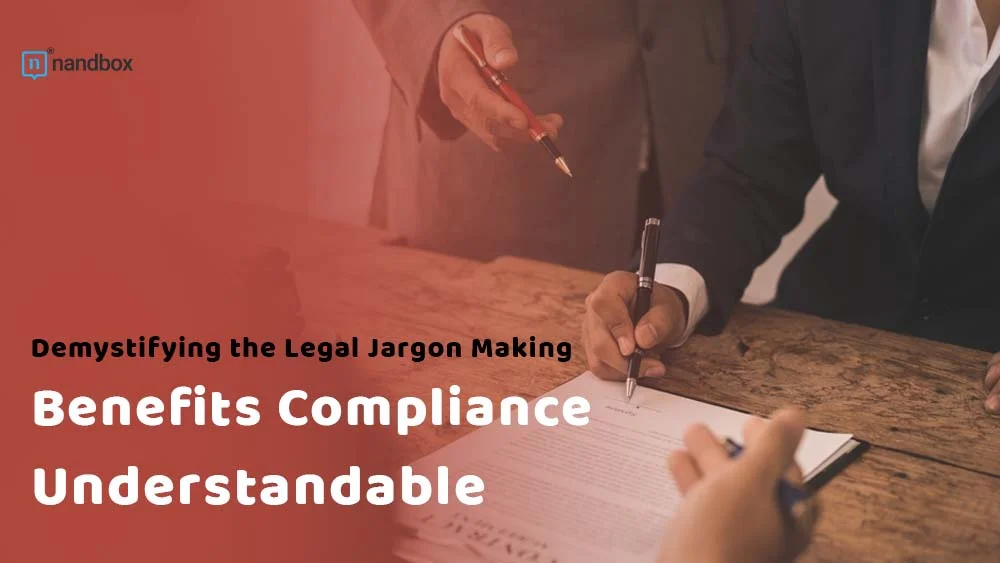Compliance remains a cornerstone that cannot be overlooked in the complex landscape of employee benefits. Specifically, as you step into 2023, the realm of compliance for employee benefits is adorned with a myriad of legal jargon. This complexity can leave even seasoned HR professionals scratching their heads. However, fear not, for this blog post is here to serve a critical purpose: to demystify the convoluted terminologies. Accordingly, we will shed light on the current year’s key legal jargon surrounding benefits compliance.
ACA (Affordable Care Act)
The ACA, a landmark healthcare reform law, continues to shape the benefits landscape. It mandates that applicable large employers (ALEs) provide affordable health insurance coverage to their full-time employees and their dependents. The “employer mandate” ensures compliance with specific coverage and affordability requirements, steering clear of hefty penalties.
ERISA (Employee Retirement Income Security Act)
ERISA is the bedrock of employee benefits regulation. It sets forth standards for pension and welfare plans provided by private employers. This statute ensures fiduciary responsibilities and disclosure requirements and safeguards employees’ interests by laying down rules for proper administration and oversight of these plans.
HIPAA (Health Insurance Portability and Accountability Act)
HIPAA safeguards the sensitive health information of employees. In a compliance context, it pertains to the privacy and security of health-related data, emphasizing strict controls on the dissemination of this information. Ensuring HIPAA compliance in telemedicine video conferencing tools and APIs is essential for safeguarding patient data, as it reinforces strict privacy standards and enables secure communication between healthcare professionals and patients in virtual settings.
SPD (Summary Plan Description)
This is a crucial document that ALEs are mandated to provide to employees. The SPD outlines the terms and conditions of the benefits plan, ensuring that employees are well-informed about their rights, responsibilities, and the benefits they are entitled to.
COBRA (Consolidated Omnibus Budget Reconciliation Act)
COBRA gives employees who leave their jobs or experience certain qualifying events the right to continue their employer-sponsored health insurance coverage for a limited period. Employers must adhere to strict notice and administrative requirements to remain compliant.
FMLA (Family and Medical Leave Act)
While not solely a benefits compliance term, FMLA intertwines with employee benefits. It grants eligible employees unpaid, job-protected leave for specific family and medical reasons while maintaining their health benefits during the leave.
SPD Wrap Document
This document wraps around different benefit plans and consolidates them into a single entity, ensuring compliance with ERISA’s disclosure requirements. It simplifies the process of providing comprehensive information to employees about their benefits.
HSA (Health Savings Account) and FSA (Flexible Spending Account)
These tax-advantaged accounts allow employees to set aside pre-tax funds for qualified medical expenses. Employers must comply with IRS regulations regarding these accounts’ contributions, distributions, and recordkeeping.
EAP (Employee Assistance Program)
EAPs offer support to employees dealing with personal issues affecting their work performance. While not as heavily regulated as health plans, employers must ensure that EAPs comply with applicable laws, such as HIPAA, when handling sensitive employee information.
Section 125 Plan (Cafeteria Plan)
These plans allow employees to choose between taxable benefits (cash) and certain qualified benefits (like health insurance) on a pre-tax basis. They are subject to strict IRS regulations to maintain their tax-favored status.
Non-Discrimination Testing
To ensure fairness, benefits plans must first undergo non-discrimination testing. Essentially, this assessment aims to prevent highly compensated employees from receiving disproportionately larger benefits compared to non-highly compensated employees. Should plans fail these tests, it then becomes necessary to make adjustments in order to maintain compliance.
SPD Communication and Delivery Rules
ERISA demands that SPDs (Summary Plan Descriptions) be communicated to employees clearly and understandably. To elaborate, in this digital age, ensuring compliance isn’t just about the content but also the method of delivery. Specifically, this involves adhering to electronic delivery regulations while, at the same time, guaranteeing easy accessibility to the information.
Nondiscrimination Rules
These rules focus on preventing discrimination in favor of highly compensated employees (HCEs) within self-insured health plans. To maintain compliance, plans must pass certain tests to ensure that benefits do not disproportionately favor HCEs, thereby promoting employee fairness. These rules extend to other benefits, such as group term life insurance, to prevent preferential treatment.
Final Thoughts
Navigating the intricate maze of compliance for employee benefits in 2023 requires a clear understanding of the legal jargon surrounding it. From ACA and ERISA to HIPAA and COBRA, each term carries significance in shaping how employers manage their benefits offerings and ensure the well-being of their employees. By deciphering and demystifying these terms, HR professionals can pave the way for a compliant and employee-centric benefits landscape.
Author’s name: Micheal Roy




